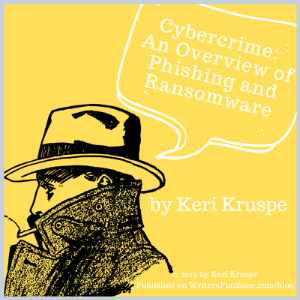Cybercrime: An Overview of Phishing and Ransomware by Keri Kruspe
 Let’s welcome back monthly columnist Keri Kruspe as she shares with us “Cybercrime: An Overview of Phishing and Ransomware.” Enjoy!
Let’s welcome back monthly columnist Keri Kruspe as she shares with us “Cybercrime: An Overview of Phishing and Ransomware.” Enjoy!
***
I’ve been working for the banking industry for over thirty years and one thing hasn’t changed in all that time. Bandits are out there and they want your money.
Personally, I’ve survived numerous physical bank robberies as well as bomb threats over the years.
Working in Las Vegas for most of those years, I’ve watched how desperate people who lost it all at the casinos have resorted to do the unthinkable by robbing others. The threat was real… it was in your face and unavoidable. How you reacted to it determined the trauma afterward.
But during the ensuing years another type of robbery has gained momentum to the unwary. While it might not be as physically dangerous as a bank robbery, it can have devastating consequences that the victim has to deal with for months, if not years.
Cybercrime: Are You Being Misled?
I’m talking about cybercrime, especially in regards to your bank account or credit cards.
In this article, I’m going to touch on a couple of areas and
- Define phishing and ransomware
- Help you understand and identify common cybercrime tactics.
- Then armed with this knowledge, offer how you can protect yourself.
Phishing and Ransomware: Social Engineering
 Social engineering is the practice of manipulating people into giving up confidential information (like passwords, bank account information, or access to a computer or network).
Social engineering is the practice of manipulating people into giving up confidential information (like passwords, bank account information, or access to a computer or network).
Social engineering is so popular with criminals because it works! It’s easier to exploit someone’s instinct to trust rather than hack into a security program (or walk into a bank and point a gun at a hapless teller.)
Social engineering usually comes in an email, text, or phone call. These thugs pose as a legitimate institution and is designed to imitate a trusted business, financial institution, social media site, or government agency. These messages will ask for private information or will get victims to unknowingly download malicious software.
Cybercrime: History of Phishing
The term phishing became popular in the mid-1990’s. It’s a variation of the word “fishing” because phishers lure their victims with bait, such as an attractive offer.
In 2004 the first phishing lawsuit was filed against a California teenager who created an imitation of the website America Online. He gained sensitive information from users and had access to credit card details to withdraw money from their accounts.
It is estimated that 1 in every 3,000 emails sent are phishing emails that costs companies in America an average of $1.3 million dollars.
Cybercrime: Phishing Tactics
A phishing email or text is designed to gain your trust and then trigger a response. It may include upsetting or exciting info that demands an urgent response.
Typical words used are: “urgent,” “important,” or “outstanding payment.” These communications will ask you to “update,” “validate,” or “confirm” your account information online.
 They’ll pray on greed by making attractive offers. They’ll claim “You’ve won a free trip or lottery. Just click here and it’s yours!”
They’ll pray on greed by making attractive offers. They’ll claim “You’ve won a free trip or lottery. Just click here and it’s yours!”
What they’re looking for are: social security numbers, full name, date of birth, full address, retail shopping account, loyalty reward accounts, username and password for online services, email account access, personal identification numbers (PIN), credit card, and bank account numbers.
How to Recognize a Phishing Attack
Here are some basic characteristics of phishing emails:
- Generic Names “Dear Customer”
- Poor spelling and grammar
- Links to another website
- Unrealistic threats/demands/offers
- Sender’s emails address may look like a known organization, but something is off
- Logos and Branding – somewhat similar but just a bit off
Malware
Malware is short for “malicious software” and is a type of cyber-attack that typically starts with a successful phishing assault. It’s intentionally designed to cause damage after being implanted to a computer or server. These can be viruses, worms, adware, Trojan horses, and ransomware.
Ransomware
 This is a sophisticated type of malware that is delivered to your computer via a phishing attack. Once it invades your computer, it stops you from using it and encrypts your files.
This is a sophisticated type of malware that is delivered to your computer via a phishing attack. Once it invades your computer, it stops you from using it and encrypts your files.
You don’t have access to your computer unless a sum of money is paid to unlock the system with a decryption key. An advanced ransomware will encrypt system files, drives, or Master File Table.
It’s almost impossible to recover from as the files cannot be accessed without the decryption key.
How to Prevent Ransomware
- Watch out for phishing. Ransomware is often delivered by a successful phishing attack.
- Install Anit-Virus software.
- Back up data.
- Filter emails.
What you can do on your own to prevent or mitigate cybercrime
- Keep an eye out for suspicious emails.
- Don’t be fooled by a “real-looking” email/website.
- Don’t click on links in an email unless you really know who the sender is.
- Protect your computer.
- Secure your website.
- When in doubt, don’t take chances.
Let’s have some fun…check out your knowledge!
- You receive an email from your credit card company asking you to visit their site to read an important notice. What is the safest way to navigate to the company’s website?
- Click on the link provided.
- Type the URL in the address bar of your browser.
- What is the purpose of phishing?
- To trick a targeted individual into handing over sensitive info.
- To teach people to be more careful with their passwords.
- Ransomware is a type of malware designed to ___________
- Hack your computer for sensitive information.
- Prevent you from accessing your computer until you pay a sum of money.
- Phishing is the process by which a targeted individual is contacted electronically by someone posing as a _________________
- Friend or family member.
- Legitimate institute.
- Concerned citizen.
How did you do? The right answers
1-b
2-a
3-b
4-b
As our technology progresses, so will the criminals advance their ability to steal our hard-earned money. But, fear not… all is not lost.
Just remain diligent and remember that no financial institution will send you an email asking for personal information or to click a link.
If you are unsure, call whatever place the email claims it’s from to verify its authenticity.

Avoid any link clicking. Better yet — don’t open a strange email you are unsure of.
I know it’s a cliché, but keep this in mind…
…if it’s too good to be true…it usually is.
***
ABOUT THE AUTHOR
Keri Kruspe has been an author since the age of twelve and has always been fascinated with otherworldly stories that end in Happily Ever After. Author of Otherworldly Romantic Adventures, Keri’s first series is An Alien Exchange trilogy. An Alien Exchange is the first book in the arousing Alien Exchange sci-fi romance series. If you like sexy aliens, feisty heroines, and fast-paced action, then you’ll love Keri Kruspe’s steamy space adventure.
has been an author since the age of twelve and has always been fascinated with otherworldly stories that end in Happily Ever After. Author of Otherworldly Romantic Adventures, Keri’s first series is An Alien Exchange trilogy. An Alien Exchange is the first book in the arousing Alien Exchange sci-fi romance series. If you like sexy aliens, feisty heroines, and fast-paced action, then you’ll love Keri Kruspe’s steamy space adventure.
Keri now resides with her family in the wilds of Northwestern Michigan. An avid reader, Keri enjoys good wine, good food, and watching action/adventure movies. You can find her most days immersed in her fantasy world of writing or traveling with her hubby in their RV, discovering intelligent life here on Earth. For goodies, news of upcoming releases, sign up for her newsletter at www.kerikruspe.com.







